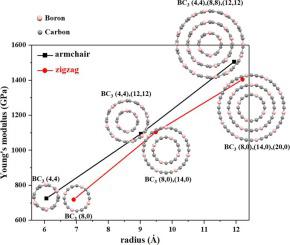当前位置:
X-MOL 学术
›
Comp. Mater. Sci.
›
论文详情
Our official English website, www.x-mol.net, welcomes your
feedback! (Note: you will need to create a separate account there.)
A theoretical scenario for the mechanical failure of boron carbide nanotubes
Computational Materials Science ( IF 3.1 ) Pub Date : 2021-01-01 , DOI: 10.1016/j.commatsci.2020.110022 Azam Salmankhani , Zohre Karami , Amin Hamed Mashhadzadeh , Maryam Zarghami Dehaghani , Mohammad Reza Saeb , Vanessa Fierro , Alain Celzard
Computational Materials Science ( IF 3.1 ) Pub Date : 2021-01-01 , DOI: 10.1016/j.commatsci.2020.110022 Azam Salmankhani , Zohre Karami , Amin Hamed Mashhadzadeh , Maryam Zarghami Dehaghani , Mohammad Reza Saeb , Vanessa Fierro , Alain Celzard

|
Abstract Although the volume of research on carbon nanotubes (CNTs) has increased over a short period, less attention has been paid to other types of carbon-based nano-objects such as boron carbide (BC3) nanotubes (BC3NTs). In the present article, we modeled BC3NTs using molecular dynamics (MD) simulation to investigate the effects of chirality, wall number, diameter and temperature on the mechanical failure of BC3NTs, BC3 nanobuds and BC3NTs with different kinds of defects. In addition, we modeled the corresponding CNTs to validate the results and understand how the replacement of a quarter of the carbon atoms in the CNT by boron atoms affects the properties of the newly formed nanotube. The results showed that the variation of mechanical properties as a function of diameter and temperature was rather limited, regardless of chirality. The Young’s modulus, failure stress and failure strain of the zigzag single-walled BC3NTs (SWBC3NTs) were lower than the armchair ones, and were lower than those of the corresponding CNTs too. Furthermore, adding a second and third wall to the SWBC3NTs significantly improved their mechanical properties. Finally, we modeled BC3 nanobuds with 1 to 4 C60 attached to the surface of SWBC3NTs and observed that the properties decreased as the number of fullerenes increased. Moreover, considering defective SWBC3NTs revealed that two-atom vacancies and Stone-Wales defects resulted in the highest and lowest reduction of mechanical properties, respectively.
中文翻译:

碳化硼纳米管机械故障的理论方案
摘要 尽管碳纳米管 (CNTs) 的研究量在短时间内有所增加,但对其他类型的碳基纳米物体,如碳化硼 (BC3) 纳米管 (BC3NTs) 的关注较少。在本文中,我们使用分子动力学 (MD) 模拟对 BC3NT 进行建模,以研究手性、壁数、直径和温度对 BC3NT、BC3 纳米芽和具有不同类型缺陷的 BC3NT 机械故障的影响。此外,我们对相应的碳纳米管进行了建模以验证结果并了解硼原子取代碳纳米管中四分之一的碳原子如何影响新形成的纳米管的特性。结果表明,无论手性如何,机械性能随直径和温度的变化都相当有限。锯齿形单壁 BC3NTs (SWBC3NTs) 的杨氏模量、破坏应力和破坏应变低于扶手椅型,也低于相应的 CNTs。此外,为 SWBC3NT 添加第二和第三壁显着改善了它们的机械性能。最后,我们模拟了 BC3 纳米芽,其中 1 到 4 个 C60 连接到 SWBC3NT 的表面,并观察到随着富勒烯数量的增加,这些特性会降低。此外,考虑到有缺陷的 SWBC3NT,两个原子空位和 Stone-Wales 缺陷分别导致机械性能的最高和最低降低。为 SWBC3NT 添加第二和第三壁显着改善了它们的机械性能。最后,我们模拟了 BC3 纳米芽,其中 1 到 4 个 C60 连接到 SWBC3NT 的表面,并观察到随着富勒烯数量的增加,这些特性会降低。此外,考虑到有缺陷的 SWBC3NT,两个原子空位和 Stone-Wales 缺陷分别导致机械性能的最高和最低降低。为 SWBC3NT 添加第二和第三壁显着改善了它们的机械性能。最后,我们模拟了 BC3 纳米芽,其中 1 到 4 个 C60 连接到 SWBC3NT 的表面,并观察到随着富勒烯数量的增加,这些特性会降低。此外,考虑到有缺陷的 SWBC3NT,两个原子空位和 Stone-Wales 缺陷分别导致机械性能的最高和最低降低。
更新日期:2021-01-01
中文翻译:

碳化硼纳米管机械故障的理论方案
摘要 尽管碳纳米管 (CNTs) 的研究量在短时间内有所增加,但对其他类型的碳基纳米物体,如碳化硼 (BC3) 纳米管 (BC3NTs) 的关注较少。在本文中,我们使用分子动力学 (MD) 模拟对 BC3NT 进行建模,以研究手性、壁数、直径和温度对 BC3NT、BC3 纳米芽和具有不同类型缺陷的 BC3NT 机械故障的影响。此外,我们对相应的碳纳米管进行了建模以验证结果并了解硼原子取代碳纳米管中四分之一的碳原子如何影响新形成的纳米管的特性。结果表明,无论手性如何,机械性能随直径和温度的变化都相当有限。锯齿形单壁 BC3NTs (SWBC3NTs) 的杨氏模量、破坏应力和破坏应变低于扶手椅型,也低于相应的 CNTs。此外,为 SWBC3NT 添加第二和第三壁显着改善了它们的机械性能。最后,我们模拟了 BC3 纳米芽,其中 1 到 4 个 C60 连接到 SWBC3NT 的表面,并观察到随着富勒烯数量的增加,这些特性会降低。此外,考虑到有缺陷的 SWBC3NT,两个原子空位和 Stone-Wales 缺陷分别导致机械性能的最高和最低降低。为 SWBC3NT 添加第二和第三壁显着改善了它们的机械性能。最后,我们模拟了 BC3 纳米芽,其中 1 到 4 个 C60 连接到 SWBC3NT 的表面,并观察到随着富勒烯数量的增加,这些特性会降低。此外,考虑到有缺陷的 SWBC3NT,两个原子空位和 Stone-Wales 缺陷分别导致机械性能的最高和最低降低。为 SWBC3NT 添加第二和第三壁显着改善了它们的机械性能。最后,我们模拟了 BC3 纳米芽,其中 1 到 4 个 C60 连接到 SWBC3NT 的表面,并观察到随着富勒烯数量的增加,这些特性会降低。此外,考虑到有缺陷的 SWBC3NT,两个原子空位和 Stone-Wales 缺陷分别导致机械性能的最高和最低降低。











































 京公网安备 11010802027423号
京公网安备 11010802027423号